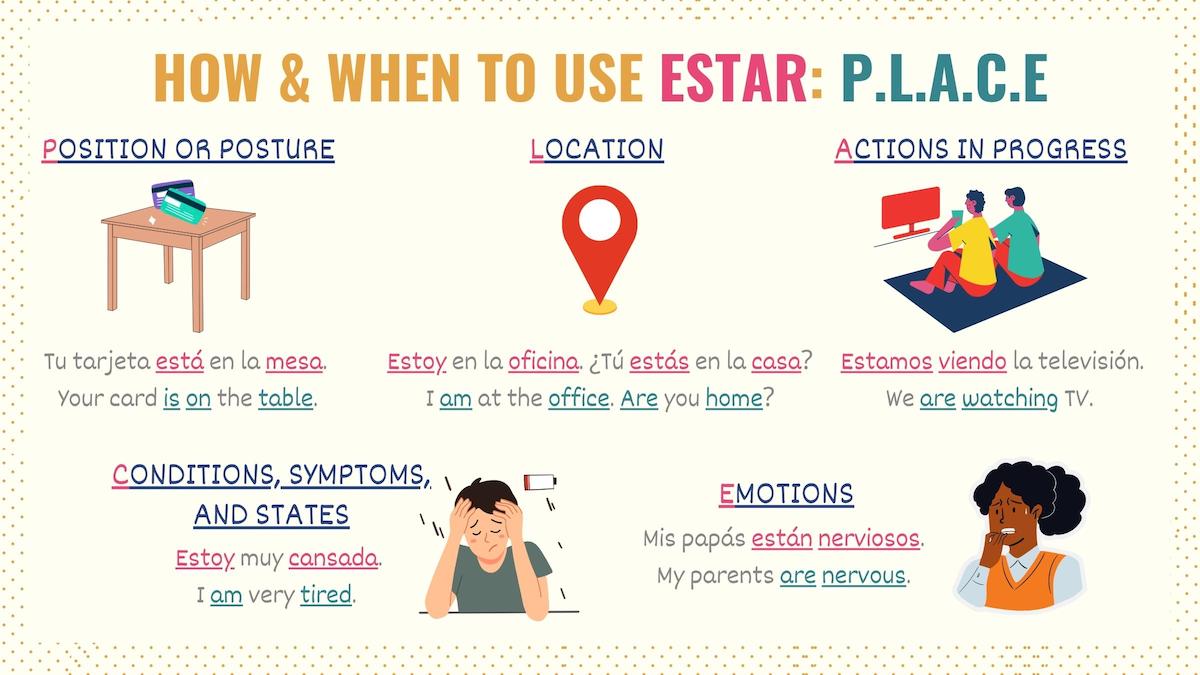Most Spanish learners struggle to understand when to use estar instead of ser. The problem with these tricky words is that they both mean ‘to be’, and some of their uses seem to overlap. Since estar is one of the most important verbs in Spanish, in this guide, you’ll learn how and when to use this verb correctly.
Here is an overview of what we’ll cover:
- How to Use Estar in Spanish
- Basic Idiomatic Expressions
- Ser vs Estar
- Key Points
- Next Steps & Resources
I’ve included real-life applications and examples to make this guide comprehensive. Let’s do this!
How & When to Use Estar in Spanish?
As mentioned above, in Spanish, estar means ‘to be’. However, this verb is only used in highly specific situations.
In Spanish, we use estar to express:
- Position or posture
- Location
- Actions in progress
- Conditions, symptoms, and states
- Emotions
The acronym P.L.A.C.E. is a common way to remember the core applications of estar.

However, be aware that other common applications aren’t easy to infer from this acronym. So, I came up with my own personal trick which you can use. Estar answers the questions:
- Where is someone?
- How is someone feeling?
- How is the weather today?
- What is someone doing?
- What is today’s date and the current price of something?
These questions still relate to and cover PLACE uses. In the sections below, we’ll check these applications more thoroughly.
Take Note: The verb estar in Spanish has a short-term nature. In other words, it refers to temporary states (feelings, location, traits) that can change over time.
Position and posture
Estar in Spanish allows you to describe someone or something’s position in relation to their surroundings. This use is formed with prepositions of location or the preposition a if you’re using numbers.
[Estar conjugated] + [preposition] + [complement]
Tu tarjeta está en la mesa.
Your card is on the table.
Hoy estamos a 10 de junio.
Today is June 10.
Ya casi llegamos. Estamos a dos cuadras.
We’re almost there. We are two blocks away.
Notice that we can refer to a physical or abstract position, such as the date. In Spanish, estar a + date is an informal way to say today’s date.
In this context, estar also expresses something or someone’s posture:
Los niños están sentados.
The kids are sitting.
¿Por qué estás de rodillas?
Why are you on your knees?
Take Note: Notice that expressions using body parts in Spanish work with prepositions. For example, a gatas (on your knees) or cruzado de brazos (crossed arms).
Location
One of the most common applications of estar is to express where something or someone is located. Here are some examples:
¿Dónde está la librería?
Where is the library?
Los perros no están aquí.
The dogs are not here.
Estoy en la oficina. ¿Tú estás en la casa?
I am at the office. Are you home?
Use the preposition en to introduce the place where someone is. You don’t need this preposition to ask where a person or place is located.
Take Note: Location and position are often confused because of their similarities. Position describes where something is in relation to its surroundings, whereas location expresses the place where a person or thing is.
Actions in progress
Estar + gerundio is a basic structure in Spanish that indicates that an action is happening at the moment of speaking. For instance:
[Estar conjugated] + [present participle]
¿Qué están haciendo?
What are you guys doing?
Estamos viendo la televisión.
We are watching TV.
Hoy está haciendo mucho calor.
Today is very hot.
Mike está hablando con Luis.
Mike is talking to Luis.
Take Note: With this application, estar is an auxiliary verb in Spanish and complements a main verb. In grammar, combining this verb with a gerund is known as the progressive tenses.
Conditions and states
The terms ‘conditions and states’ involve a temporary nature. Simply put, these are not inherent qualities and will eventually or could change. Some real-life contexts where we use estar to talk about conditions and states include:
- Physical states
- Temporary traits
- Marital status
- Current price of something
- Occupation
First, check these sentences with adjectives:
[Estar conjugated] + [adjective]
Estoy muy cansada.
I am very tired.
Sam está enfermo.
Sam is sick.
Allison y Ben no están casados.
Allison and Ben are not married.
¿Te sientes bien? Estás pálida.
Are you feeling okay? You are pale.
Because it looks like we’re describing people, this use is often confused with ser. However, there is a big nuance in meaning: these are states rather than permanent traits. Take sentence #4 as an example.
Estás cansada is my current condition. However, I’m going to stop feeling this way as soon as I rest.
Conditions and states can also include the current occupation or the price of something:
Marianne está de mesera.
Marianne is a waitress.
La manzana está a veinte pesos el kilo.
The apple is twenty pesos per kilo.
Like the previous examples, these sentences also imply a temporary nature. This is not necessarily Marianne’s profession forever and prices could go through the roof tomorrow.

Emotions
In Spanish, we use estar to talk about feelings because emotions are not perpetual. How we feel now may not be how we feel in the future.
When it comes to feelings, estar often works with the following adjectives:
- Aburrido: Bored
- Asustado: Scared
- Confundido: Confused
- Contento: Happy
- Decepcionado: Disappointed
- Enojado: Mad
- Feliz: Happy
- Nervioso: Nervous
- Relajado: Relaxed
- Preocupado: Worried
- Sucio: Dirty
- Tranquilo: Calm
- Triste: Sad
¿Por qué estás enojado?
Why are you mad?
Estamos muy felices.
We are very happy.
Mis papás están nerviosos.
My parents are nervous.
Lorena está tranquila porque hizo lo que pudo.
Lorena is calm because she did what she could.
Take Note: Adjectives ending in -ado or -ido are called past participles in Spanish. They’re often used with estar to describe how someone is feeling. Notice that Spanish adjectives must mark the gender and plural form.
Idiomatic Expressions with Estar
Like other verbs in Spanish, estar is also used in idiomatic expressions. Here are some common expressions that can help you sound more natural:
- Estar al tanto: To be aware
- Estar bueno: To be hot / To be sexy
- Estar como una cabra: To be crazy
- Estar como una cuba: To be very drunk
- Estar como pez en el agua: To be in one’s element
- Estar de malas: To be in a bad mood
- Estar de vicio: To die for / Great
- Estar en ascuas: To be on edge
- Estar en la luna: To have your head in the clouds
- Estar en las manos de alguien: To be in one’s hand
- Estar en las últimas: To be in bad shape
- Estar por hacer: To be about to do
- Estar por verse: To remain to be seen
- Saber estar: Know how to behave
Difference Between Estar and Ser in Spanish
In a nutshell, ser expresses what someone is, whereas estar communicates how or where someone is. Ser refers to permanent or inherent traits, such as profession, nationality, physical appearance, personality, and family relationships. On the contrary, estar communicates temporary characteristics.
Check these examples:
| Ser | Estar |
|---|---|
| Mis vecinos son muy pálidos. My neighbors are very pale. | Los niños están muy pálidos. The kids are very pale. |
| Tú eres maestra de inglés. You are an English teacher. | Tú estás de niñera. You are a babysitter. |
| La película es aburrida. The movie is boring. | Tu hermana está aburrida. Your sister is bored. |
In most cases, sentences with estar and ser have the same translation. However, in Spanish, the verb estar refers to short-term conditions that will cease to exist or continue, whereas ser defines what someone or something is.
Take the first pair of sentences. Ser pálido refers to an inherent physical trait that is part of your natural complexion. On the other hand, estar pálido implies that your current paleness isn’t your natural color, and there’s a reason why you look that way.

Like in English, the verb to be in Spanish is crucial. So, make sure you understand the difference between ser and estar.
Key Points
Because it allows you to describe temporary states and build more advanced tenses, the verb estar is crucial for Spanish conversations. Here are some key points to keep in mind:
- Estar in Spanish means ‘to be’.
- This verb refers to temporary conditions and traits (things that are going to change).
- Estar is used to talk about:
- Position and posture
- Location
- Actions in progress
- Conditions and states
- Emotions
- Adjectives that work with estar refer to a variable current or short-term characteristic.
- When talking about someone’s job, estar refers to a current occupation.
- Unlike estar, ser refers to inherent and permanent qualities.
I encourage you to take our ser vs estar practice quiz to reinforce what you just learned.
Next Steps & Resources to Master Estar in Spanish
Now that you know when to use estar in Spanish, here are your next steps.
First, get familiar with estar conjugation patterns since this verb has some irregularities. Once you’re comfortable with its conjugations, you can take this conjugation practice quiz.
As you already know, this verb is key to forming other Spanish tenses. Although they all are important, you can start by checking how to use the present progressive.
Depending on the application, estar works with different elements. So, make sure you know:
- How to Form Spanish Past Participles
- How to Form Present Participles in Spanish
- Basic Spanish Adjectives
Download PDF
As one of the equivalents of ‘to be’, the verb estar in Spanish is crucial for communication. Because of this, I’ve compiled this downloadable PDF so that you can always check when and how to use this verb.



